fuel cap release MERCEDES-BENZ GL 2012 Owners Manual
[x] Cancel search | Manufacturer: MERCEDES-BENZ, Model Year: 2012, Model line: GL, Model: MERCEDES-BENZ GL 2012Pages: 384, PDF Size: 15.71 MB
Page 11 of 384

EASY-PACK load-securing kit ........... 275
EBD (electronic brake force
distribution) Display message ............................ 235
Function/notes ................................ 71
Electrical fuses
see Fuses
Electronic Brake force Distribution
see EBD (Electronic Brake force
Distribution)
Electronic Stability Program
see ESP ®
(Electronic Stability Program)
Electronic Traction System
see 4ETS (Electronic Traction System)
Emergency release
Driver's door .................................... 85
Fuel filler flap ................................. 161
Vehicle ............................................. 85
Emergency spare wheel
Storage location ............................ 315
Emergency Tensioning Devices
Function ........................................... 59
Safety guidelines ............................. 39
Emissions purification
Service and warranty information ....21
Engine
Check Engine warning lamp ........... 264
Display message ............................ 244
Emergency starting ........................333
Engine number ............................... 370
Irregular running ............................ 153
Starting problems ..........................153
Starting the engine with the
SmartKey ....................................... 150
Starting with KEYLESS-GO .............151
Switching off .................................. 166
Engine electronics
Problem (malfunction) ...................153
Engine emergency stop .................... 335
Engine oil Adding ........................................... 302
Additives ........................................ 375
Checking the oil level ..................... 301
Display message ............................ 246
Filling capacity ............................... 371
Notes about oil grades ................... 375Notes on oil level/consumption ....301
Viscosity ........................................ 375
ESP ®
(Electronic Stability
Program) 4ETS ................................................ 70
Deactivating/activating ...................70
Display message ............................ 233
Function/notes ................................ 69
Important safety information ...........69
Trailer stabilization ........................... 71
Warning lamp ................................. 261
Exhaust check ................................... 169
Exhaust tail pipe (cleaning
instructions) ...................................... 310
Exterior lighting see Lights
Exterior mirrors
Adjusting ....................................... 112
Dipping (automatic) .......................113
Folding in/out (automatically) .......113
Folding in/out (electrically) ...........112
Folding in when locking (on-board
computer) ...................................... 228
Out of position (troubleshooting) ...113
Setting ........................................... 113
Storing settings (memory
function) ........................................ 114
Storing the parking position ..........113
F
Filler cap see Fuel filler flap
First-aid kit ......................................... 314
Flat tire Changing a wheel/mounting the
spare wheel ................................... 321
MOExtended run-flat system .........325
Preparing the vehicle .....................316
Raising the vehicle .........................322
TIREFIT kit ...................................... 317
Floormat ............................................. 297
Fording Off-road ......................................... 171
On flooded roads ........................... 171
Front fog lamp
Switching on/off ........................... 120
Index9
Page 12 of 384
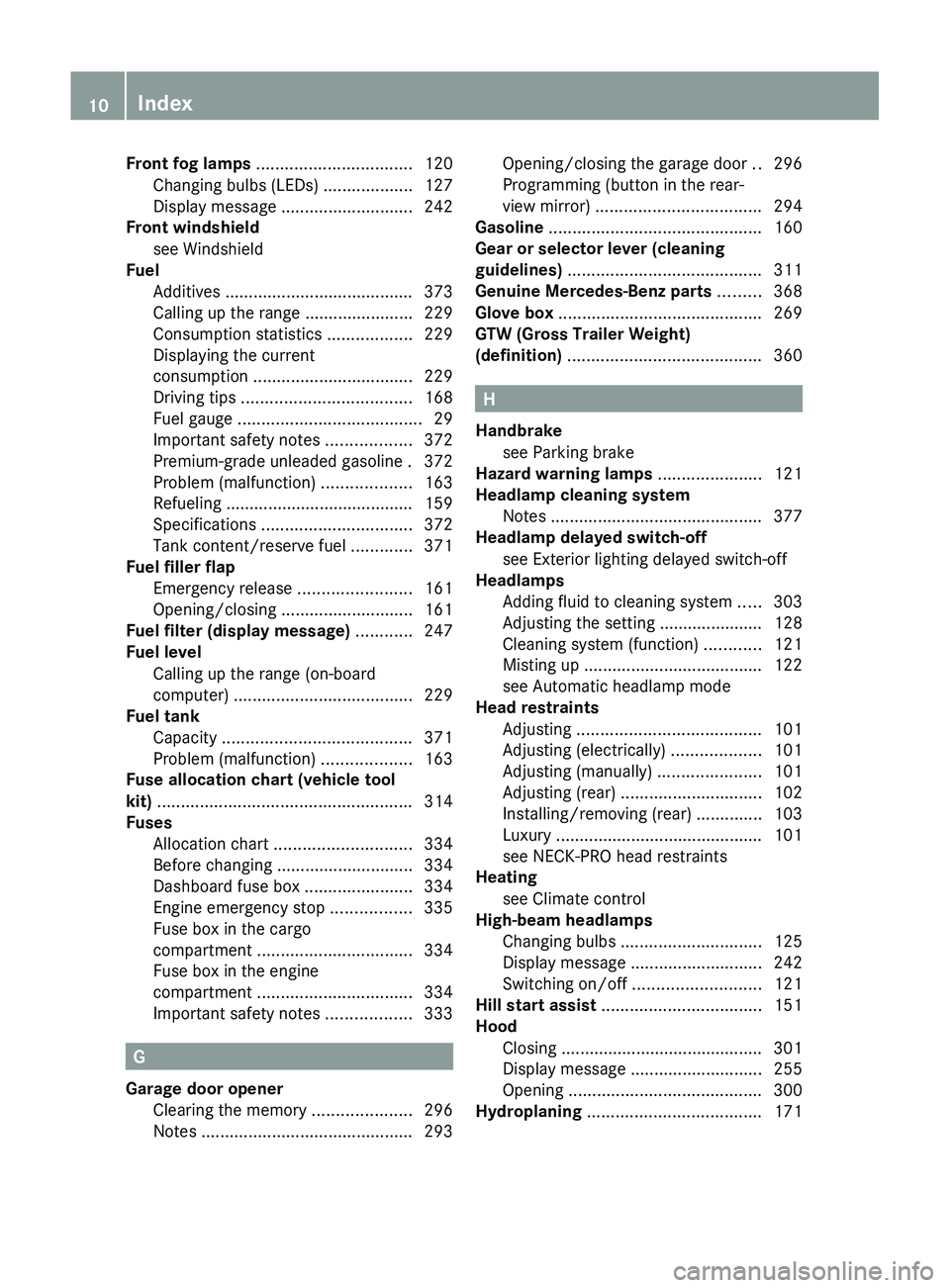
Front fog lamps ................................. 120
Changing bulbs (LEDs) ...................127
Display message ............................ 242
Front windshield
see Windshield
Fuel
Additives ........................................ 373
Calling up the range .......................229
Consumption statistics ..................229
Displaying the current
consumption .................................. 229
Driving tips .................................... 168
Fuel gauge ....................................... 29
Important safety notes ..................372
Premium-grade unleaded gasoline . 372
Problem (malfunction) ...................163
Refueling ........................................ 159
Specifications ................................ 372
Tank content/reserve fuel .............371
Fuel filler flap
Emergency release ........................161
Opening/closing ............................ 161
Fuel filter (display message) ............ 247
Fuel level Calling up the range (on-board
computer) ...................................... 229
Fuel tank
Capacity ........................................ 371
Problem (malfunction) ...................163
Fuse allocation chart (vehicle tool
kit) ...................................................... 314
Fuses Allocation chart ............................. 334
Before changing ............................. 334
Dashboard fuse box .......................334
Engine emergency stop .................335
Fuse box in the cargo
compartment ................................. 334
Fuse box in the engine
compartment ................................. 334
Important safety notes ..................333
G
Garage door opener Clearing the memory .....................296
Notes ............................................. 293
Opening/closing the garage door ..296
Programming (button in the rear-
view mirror) ................................... 294
Gasoline ............................................. 160
Gear or selector lever (cleaning
guidelines) ......................................... 311
Genuine Mercedes-Benz parts ......... 368
Glove box ........................................... 269
GTW (Gross Trailer Weight)
(definition) ......................................... 360
H
Handbrake see Parking brake
Hazard warning lamps ...................... 121
Headlamp cleaning system Notes ............................................. 377
Headlamp delayed switch-off
see Exterior lighting delayed switch-off
Headlamps
Adding fluid to cleaning system .....303
Adjusting the setting ...................... 128
Cleaning system (function) ............121
Misting up ...................................... 122
see Automatic headlamp mode
Head restraints
Adjusting ....................................... 101
Adjusting (electrically) ...................101
Adjusting (manually) ......................101
Adjusting (rear) .............................. 102
Installing/removing (rear) ..............103
Luxury ............................................ 101
see NECK-PRO head restraints
Heating
see Climate control
High-beam headlamps
Changing bulbs .............................. 125
Display message ............................ 242
Switching on/off ........................... 121
Hill start assist .................................. 151
Hood Closing ........................................... 301
Display message ............................ 255
Opening ......................................... 300
Hydroplaning ..................................... 171
10Index
Page 163 of 384
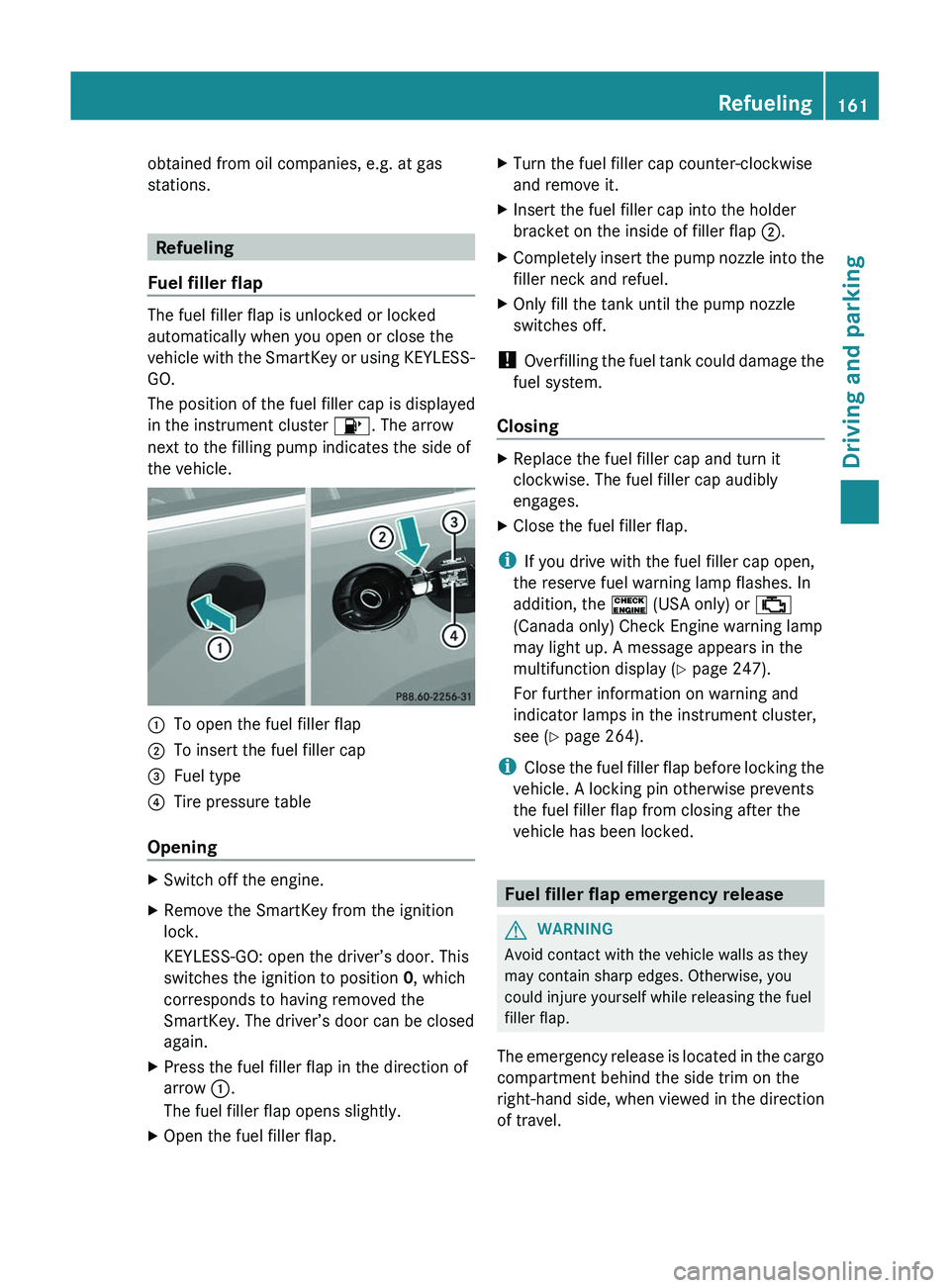
obtained from oil companies, e.g. at gas
stations.
Refueling
Fuel filler flap
The fuel filler flap is unlocked or locked
automatically when you open or close the
vehicle with the SmartKey or using KEYLESS-
GO.
The position of the fuel filler cap is displayed
in the instrument cluster 8. The arrow
next to the filling pump indicates the side of
the vehicle.
:To open the fuel filler flap;To insert the fuel filler cap=Fuel type?Tire pressure table
Opening
XSwitch off the engine.XRemove the SmartKey from the ignition
lock.
KEYLESS-GO: open the driver’s door. This
switches the ignition to position 0, which
corresponds to having removed the
SmartKey. The driver’s door can be closed
again.XPress the fuel filler flap in the direction of
arrow :.
The fuel filler flap opens slightly.XOpen the fuel filler flap.XTurn the fuel filler cap counter-clockwise
and remove it.XInsert the fuel filler cap into the holder
bracket on the inside of filler flap ;.XCompletely insert the pump nozzle into the
filler neck and refuel.XOnly fill the tank until the pump nozzle
switches off.
! Overfilling the fuel tank could damage the
fuel system.
Closing
XReplace the fuel filler cap and turn it
clockwise. The fuel filler cap audibly
engages.XClose the fuel filler flap.
i If you drive with the fuel filler cap open,
the reserve fuel warning lamp flashes. In
addition, the ! (USA only) or ;
(Canada only) Check Engine warning lamp
may light up. A message appears in the
multifunction display ( Y page 247).
For further information on warning and
indicator lamps in the instrument cluster,
see ( Y page 264).
i Close the fuel filler flap before locking the
vehicle. A locking pin otherwise prevents
the fuel filler flap from closing after the
vehicle has been locked.
Fuel filler flap emergency release
GWARNING
Avoid contact with the vehicle walls as they
may contain sharp edges. Otherwise, you
could injure yourself while releasing the fuel
filler flap.
The emergency release is located in the cargo
compartment behind the side trim on the
right-hand side, when viewed in the direction
of travel.
Refueling161Driving and parkingZ
Page 166 of 384
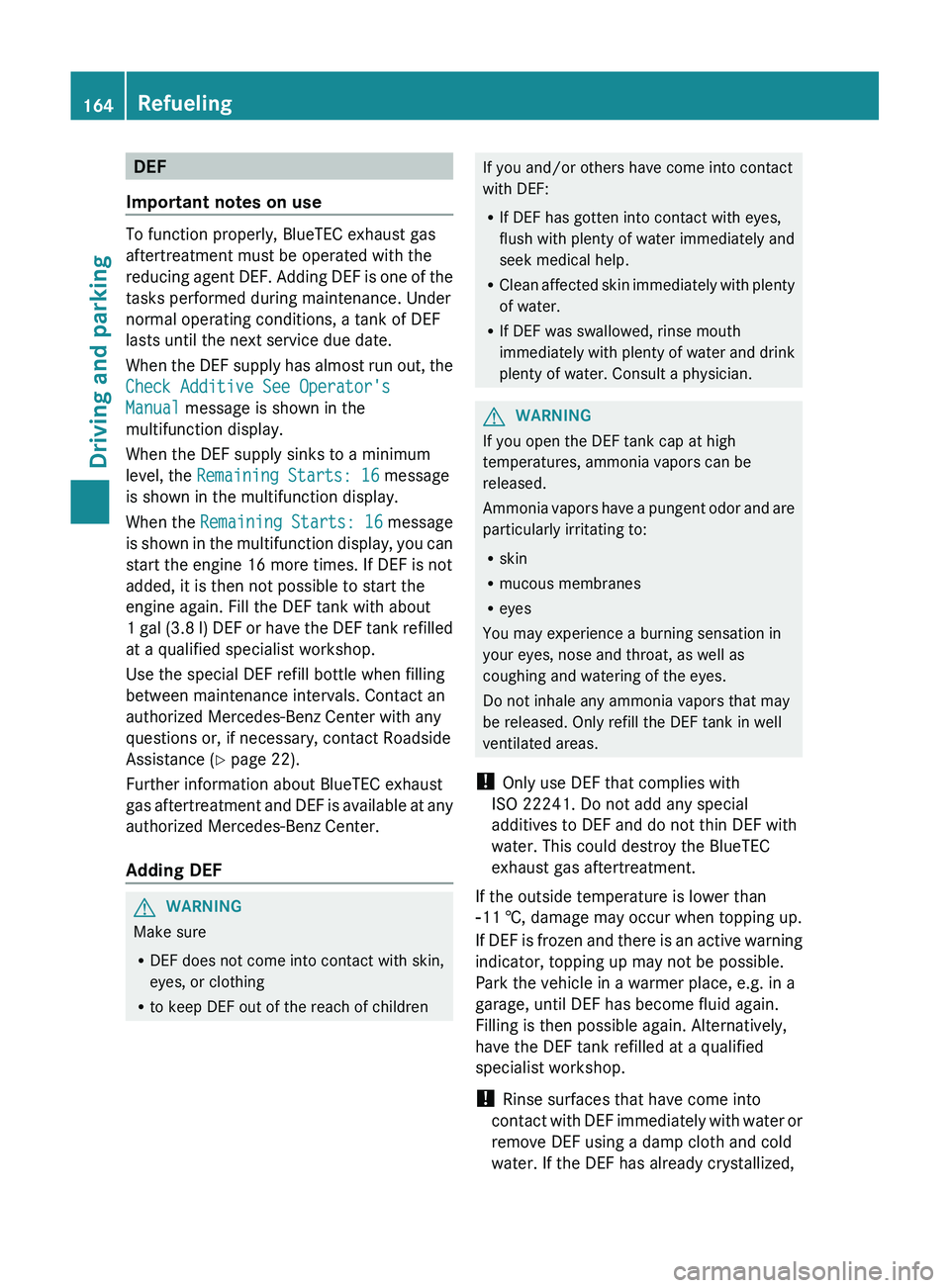
DEF
Important notes on use
To function properly, BlueTEC exhaust gas
aftertreatment must be operated with the
reducing agent DEF. Adding DEF is one of the
tasks performed during maintenance. Under
normal operating conditions, a tank of DEF
lasts until the next service due date.
When the DEF supply has almost run out, the
Check Additive See Operator's
Manual message is shown in the
multifunction display.
When the DEF supply sinks to a minimum
level, the Remaining Starts: 16 message
is shown in the multifunction display.
When the Remaining Starts: 16 message
is shown in the multifunction display, you can
start the engine 16 more times. If DEF is not
added, it is then not possible to start the
engine again. Fill the DEF tank with about
1 gal (3.8 l) DEF or have the DEF tank refilled
at a qualified specialist workshop.
Use the special DEF refill bottle when filling
between maintenance intervals. Contact an
authorized Mercedes-Benz Center with any
questions or, if necessary, contact Roadside
Assistance ( Y page 22).
Further information about BlueTEC exhaust
gas aftertreatment and DEF is available at any
authorized Mercedes-Benz Center.
Adding DEF
GWARNING
Make sure
R DEF does not come into contact with skin,
eyes, or clothing
R to keep DEF out of the reach of children
If you and/or others have come into contact
with DEF:
R If DEF has gotten into contact with eyes,
flush with plenty of water immediately and
seek medical help.
R Clean affected skin immediately with plenty
of water.
R If DEF was swallowed, rinse mouth
immediately with plenty of water and drink
plenty of water. Consult a physician.GWARNING
If you open the DEF tank cap at high
temperatures, ammonia vapors can be
released.
Ammonia vapors have a pungent odor and are
particularly irritating to:
R skin
R mucous membranes
R eyes
You may experience a burning sensation in
your eyes, nose and throat, as well as
coughing and watering of the eyes.
Do not inhale any ammonia vapors that may
be released. Only refill the DEF tank in well
ventilated areas.
! Only use DEF that complies with
ISO 22241. Do not add any special
additives to DEF and do not thin DEF with
water. This could destroy the BlueTEC
exhaust gas aftertreatment.
If the outside temperature is lower than
Ò 11 †, damage may occur when topping up.
If DEF is frozen and there is an active warning
indicator, topping up may not be possible.
Park the vehicle in a warmer place, e.g. in a
garage, until DEF has become fluid again.
Filling is then possible again. Alternatively,
have the DEF tank refilled at a qualified
specialist workshop.
! Rinse surfaces that have come into
contact with DEF immediately with water or
remove DEF using a damp cloth and cold
water. If the DEF has already crystallized,
164RefuelingDriving and parking
Page 167 of 384
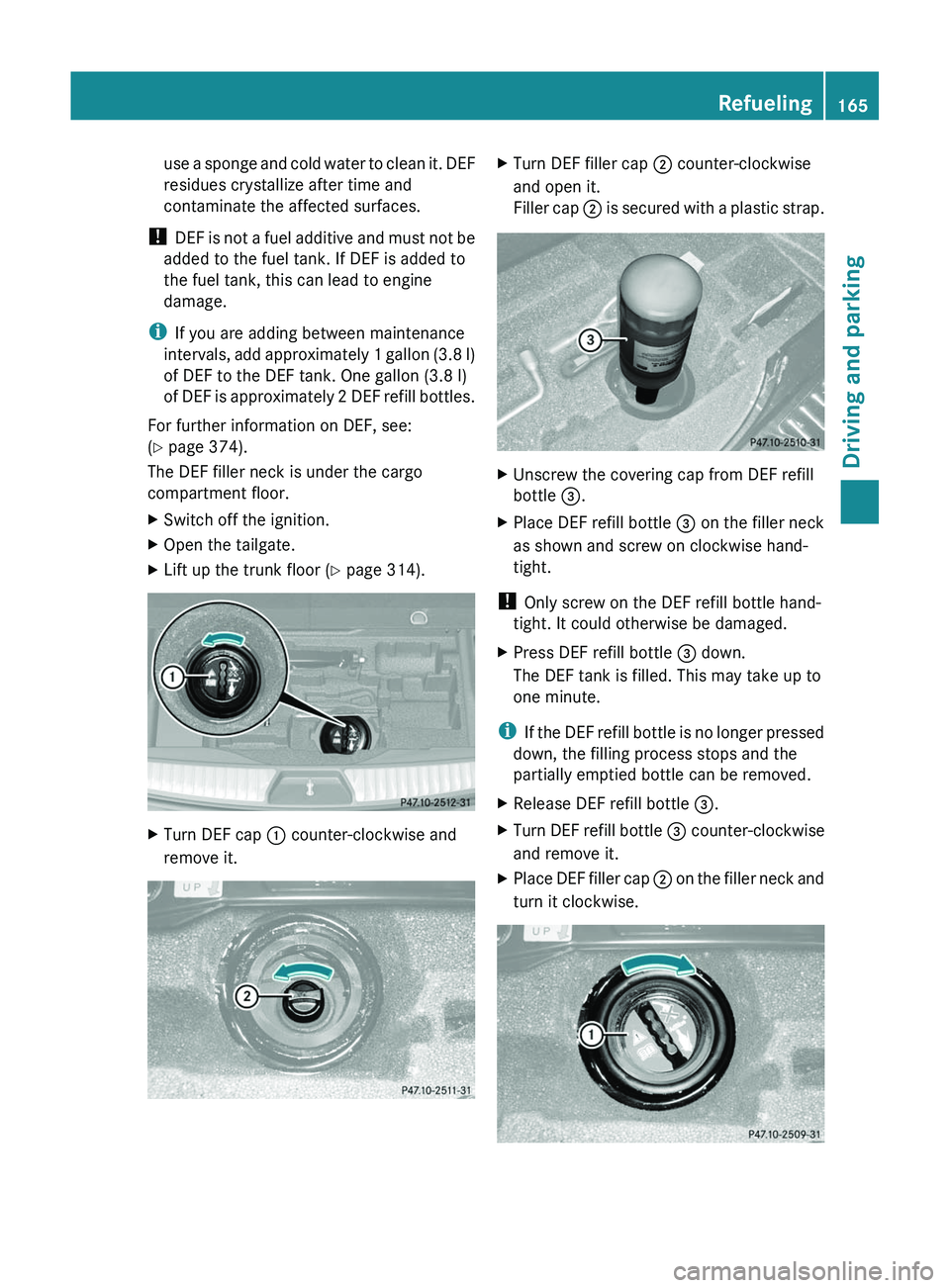
use a sponge and cold water to clean it. DEF
residues crystallize after time and
contaminate the affected surfaces.
! DEF is not a fuel additive and must not be
added to the fuel tank. If DEF is added to
the fuel tank, this can lead to engine
damage.
i If you are adding between maintenance
intervals, add approximately 1 gallon (3.8 l)
of DEF to the DEF tank. One gallon (3.8 l)
of DEF is approximately 2 DEF refill bottles.
For further information on DEF, see:
( Y page 374).
The DEF filler neck is under the cargo
compartment floor.XSwitch off the ignition.XOpen the tailgate.XLift up the trunk floor ( Y page 314).XTurn DEF cap : counter-clockwise and
remove it.XTurn DEF filler cap ; counter-clockwise
and open it.
Filler cap ; is secured with a plastic strap.XUnscrew the covering cap from DEF refill
bottle =.XPlace DEF refill bottle = on the filler neck
as shown and screw on clockwise hand-
tight.
! Only screw on the DEF refill bottle hand-
tight. It could otherwise be damaged.
XPress DEF refill bottle = down.
The DEF tank is filled. This may take up to
one minute.
i If the DEF refill bottle is no longer pressed
down, the filling process stops and the
partially emptied bottle can be removed.
XRelease DEF refill bottle =.XTurn DEF refill bottle = counter-clockwise
and remove it.XPlace DEF filler cap ; on the filler neck and
turn it clockwise.Refueling165Driving and parkingZ
Page 347 of 384
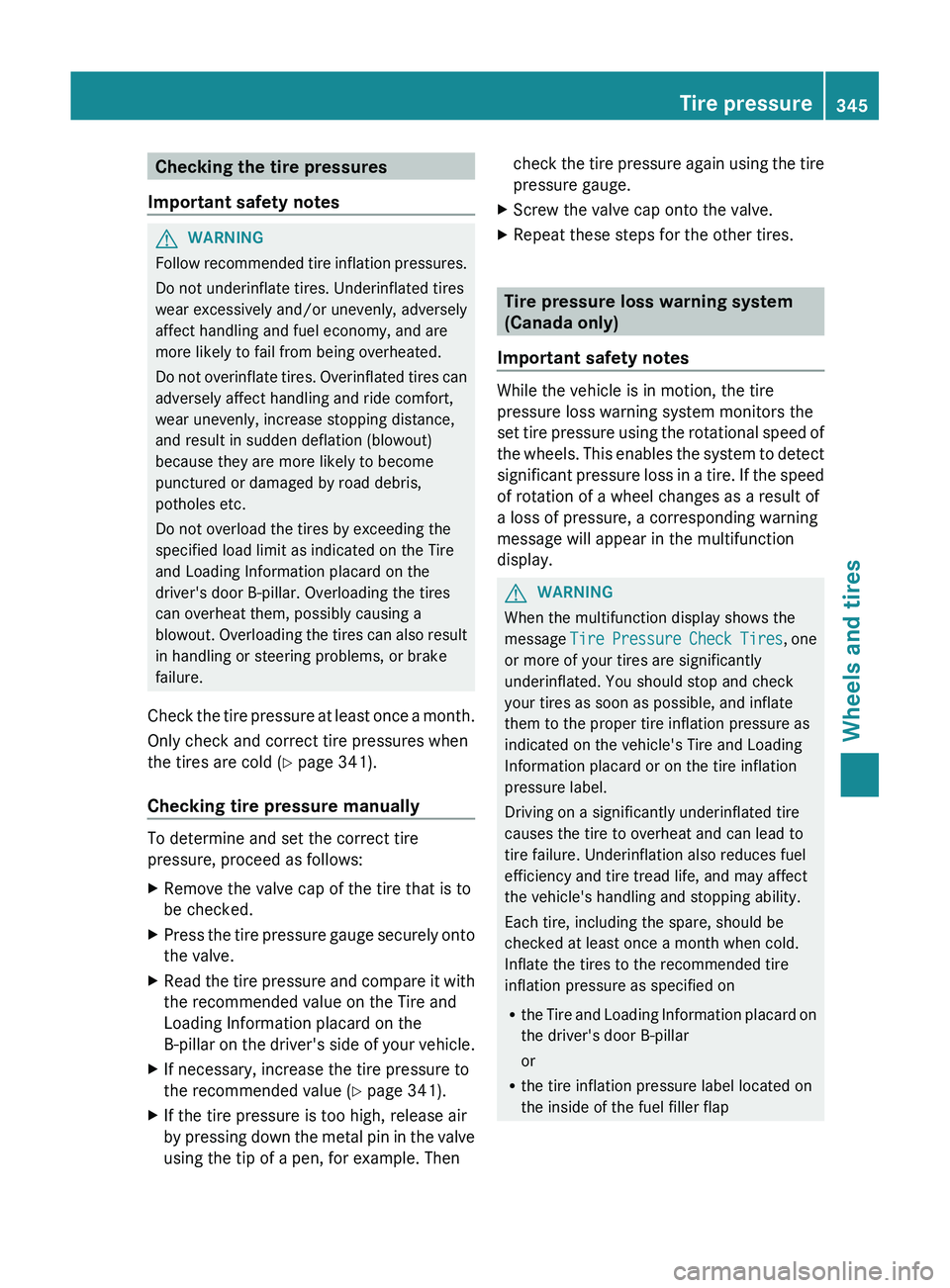
Checking the tire pressures
Important safety notesGWARNING
Follow recommended tire inflation pressures.
Do not underinflate tires. Underinflated tires
wear excessively and/or unevenly, adversely
affect handling and fuel economy, and are
more likely to fail from being overheated.
Do not overinflate tires. Overinflated tires can
adversely affect handling and ride comfort,
wear unevenly, increase stopping distance,
and result in sudden deflation (blowout)
because they are more likely to become
punctured or damaged by road debris,
potholes etc.
Do not overload the tires by exceeding the
specified load limit as indicated on the Tire
and Loading Information placard on the
driver's door B-pillar. Overloading the tires
can overheat them, possibly causing a
blowout. Overloading the tires can also result
in handling or steering problems, or brake
failure.
Check the tire pressure at least once a month.
Only check and correct tire pressures when
the tires are cold ( Y page 341).
Checking tire pressure manually
To determine and set the correct tire
pressure, proceed as follows:
XRemove the valve cap of the tire that is to
be checked.XPress the tire pressure gauge securely onto
the valve.XRead the tire pressure and compare it with
the recommended value on the Tire and
Loading Information placard on the
B-pillar on the driver's side of your vehicle.XIf necessary, increase the tire pressure to
the recommended value ( Y page 341).XIf the tire pressure is too high, release air
by pressing down the metal pin in the valve
using the tip of a pen, for example. Thencheck the tire pressure again using the tire
pressure gauge.XScrew the valve cap onto the valve.XRepeat these steps for the other tires.
Tire pressure loss warning system
(Canada only)
Important safety notes
While the vehicle is in motion, the tire
pressure loss warning system monitors the
set tire pressure using the rotational speed of
the wheels. This enables the system to detect
significant pressure loss in a tire. If the speed
of rotation of a wheel changes as a result of
a loss of pressure, a corresponding warning
message will appear in the multifunction
display.
GWARNING
When the multifunction display shows the
message Tire Pressure Check Tires , one
or more of your tires are significantly
underinflated. You should stop and check
your tires as soon as possible, and inflate
them to the proper tire inflation pressure as
indicated on the vehicle's Tire and Loading
Information placard or on the tire inflation
pressure label.
Driving on a significantly underinflated tire
causes the tire to overheat and can lead to
tire failure. Underinflation also reduces fuel
efficiency and tire tread life, and may affect
the vehicle's handling and stopping ability.
Each tire, including the spare, should be
checked at least once a month when cold.
Inflate the tires to the recommended tire
inflation pressure as specified on
R the Tire and Loading Information placard on
the driver's door B-pillar
or
R the tire inflation pressure label located on
the inside of the fuel filler flap
Tire pressure345Wheels and tiresZ